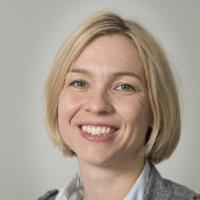Grants from the Novo Nordisk Foundation autumn 2022
Associate Professor Sine Lo Svenningsen, Professor Lotte Bang Pedersen, Professor Karen Skriver and professor Kaare Teilum all received grants from the Novo Nordisk Foundation to the following projects:

Sine Lo Svenningsen
Titel: Understanding bacteriophage behavior through the lens of the bacterial host population
Project: All known forms of cellular life can be infected by viruses. This is also true for bacteria, who become infected by tiny viruses known as bacteriophages. Bacteriophages are potent killers of bacteria, but many of them can also establish long-term infections, where they provide the bacterial hosts with useful properties, such as resistance to antibiotics or production of toxins. We now know that bacteriophages also profoundly impact the composition and function of the human microbiota, which in turn is essential for human development, health and nutrition. However, we know very little about the factors that determine how a bacteriophage infection spreads and persists in a bacterial population. In this project, we will contribute to understanding the complicated interplay between bacteriophage and bacteria. In particular, we will find out the molecular basis for how some bacteria seem to be capable of controlling the spread of bacteriophages by means of bacterial cell-to-cell signaling.
Grant: DKK 2.999.416

Lotte Bang Pedersen
Title: Targeting of pH-regulatory transport proteins to primary cilia of kidney epithelial cells
Project: Most cells in our body contain antenna-like structures on their surface called primary cilia, which are important for regulating cell-cell communication and thereby the development and function of our organs. Defects in cilia can lead to severe human diseases called ciliopathies, which often affect the kidneys. In this project we will investigate how two pH-regulatory ion transporters, NBCn1 and NHE1, are targeted to the primary cilium of mammalian kidney cells, and how they regulate pH within the cilium. NBCn1 and NHE1 regulate essential processes in our cells and organs and their dysfunction is linked to diseases like cancer and hypertension, but it is not clear how they get localized to and function at cilia. Likewise, intraciliary pH and its possible effect on ciliary function are completely unknown. The results will provide new insight into the regulation and subcellular functions of NBCn1 and NHE1, and into how pH may affect cilia-mediated signaling.
Grant: DKK 2.982.587

Karen Skriver
Title: 'The full picture: How do activation domains regulate gene expression?'
Project: In the cell nucleus, transcription factors are critical to the regulation of our genes. These proteins contain regions of well-defined form matching that of DNA thereby enabling gene-binding but they also contain regulatory regions which, because of their wild "lasso" structures, have puzzled scientists for thirty years. Here, we investigate how these protein "lassos" also regulate DNA-binding utilizing the flexibility associated with their structural disorder. We investigate how charge, local structure, and repetitive elements enable intramolecular interactions, DNA binding, and formation of supramolecular assemblies and membrane-less droplets, thereby regulating genes. We use a palette of scientific methods to link basic structural properties with intricate molecular networks to give the full picture. Since protein "lassos" can be designed to affect both DNA- and drug-binding, the results have implications for biotechnology, e.g. plant productivity, as well as human health and disease.
Grant: DKK 2.343.762

Kaare Teilum
Title: 'Phosphorous recovery using optimised phosphate binding proteins'
Project: The element phosphorus is essential for all life on earth, and to maintain the intensive agriculture required to feed the world's population, it is necessary to add phosphorus to the fertilizers that farmers use on their fields. Unfortunately, phosphorus is a limited resource that exists primarily as the mineral phosphorite. Phosphorite is quarried in mines and, after processing, used primarily as a fertilizer. The phosphorus used for fertilizer ends up as inorganic phosphate in wastewater via our food, or if it is not taken up by plants it is washed out of the fields and ends up in streams, lakes and the sea. Here it results in environmental problems such as the blooming of algae and oxygen depletion. The phosphate that ends up in wastewater or in the aquatic environment cannot be immediately collected and reused in agriculture. In this project, we wish to use phosphate binding proteins from bacteria to make a sustainable phosphate specific chromatographic column that allows us to recover phosphorous, in the form of phosphate, from polluted lakes and wastewater.To succeed we need to carefully optimize a) the conditions we use for binding and eluting the phosphate from the column, b) the binding properties and c) the stability of the phosphate binding protein itself and finally d) make a durable column that can handle large flows of an impure feedstock. We will use biophysical methods to elucidate the binding mechanism and use our understanding of this to engineer proteins with tunable binding affinity. We will use an advanced bacterial generic selection method combined with next generation sequencing to improve the stability of our phosphate binding protein. The optimized protein will be conjugated to an affinity chromatographic column base on a unique expanded bed adsorption technology. Finally, we will use mass spectrometry to analyse how protein coupled to the column degrade and use this knowledge to further stabilize the protein.
Grant: DKK 3.658.488
